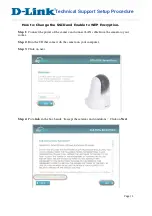
- 63 -
for reducing the size of large files and programs.
DC-Iris (Autoiris) -
This special type of iris is electrically controlled by the camera, to automatically regulate the amount of light allowed to enter.
DHCP (Dynamic Host Configuration Protocol) -
DHCP is a protocol that lets network administrators automate and centrally manage the assignment of Internet Protocol (IP)
addresses to network devices in a network.
DHCP uses the concept of a ‘lease’ or amount of time that a given IP address will be valid for a computer. The lease time can vary,
depending on how long a user is likely to require the network connection at a particular location.
DHCP also supports static addresses for e.g. computers running web servers, which need a permanent IP address.
DNS (Domain Name System) -
DNS is used to locate and translate Internet domain names into IP (Internet Protocol) addresses. A domain name is a meaningful
and easy-to-remember name for an Internet address. For example the domain name www.example.com is much easier to
remember than 192.0.34.166. The translation tables for domain names are contained in Domain name servers.
Domain Server -
Domains can also be used by organizations who wish to centralize the management of their (Windows) computers. Each user
within a domain has an account that usually allows them to log in to and use any computer in the domain, although restrictions
may also apply. The domain server is the server that authenticates the users on the network.
Ethernet -
Ethernet is the most widely installed local area network technology. An Ethernet LAN typically uses special grades of twisted pair
wires. The most commonly installed Ethernet systems are 10BASE-T and 100BASE-T10, which provide transmission speeds up to
10 Mbps and 100 Mbps respectively.
Factory default settings -
These are the settings that originally applied for a device when it was first delivered from the factory. If it should become
necessary to reset a device to its factory default settings, this will, for many devices, completely reset any settings that were
changed by the user.
Firewall -
A firewall works as a barrier between networks, e.g. between a Local Area Network and the Internet. The firewall ensures that
only authorized users are allowed to access the one network from the other. A firewall can be software running on a computer, or
it can be a standalone hardware device.
Focal length -
Measured in millimeters, the focal length of a camera lens determines the width of the horizontal field of view, which in turn is
measured in degrees.
FTP (File Transfer Protocol) -
An application protocol that uses the TCP/IP protocols. It is used to exchange files between computers/devices on networks.
Frame -
A frame is a complete video image. In the 2:1 interlaced scanning format of the RS-170 and CCIR formats, a frame is made up of
two separate fields of 262.5 or 312.5 lines interlaced at 60 or 50 Hz to form a complete frame, which appears at 30 or 25 Hz. In
video cameras with a progressive scan, each frame is scanned line-by-line and not interlaced; most are also displayed at 30 and 25
Hz.
Frame rate -
The frame rate used to describe the frequency at which a video stream is updated is measured in frames per second (fps). A
higher frame rate is advantageous when there is movement in the video stream, as it maintains image quality throughout.
Gain -
Gain is the amplification factor and the extent to which an analog amplifier boosts the strength of a signal. Amplification factors
are usually expressed in terms of power. The decibel (dB) is the most common way of quantifying the gain of an amplifier.
Gateway -
A gateway is a point in a network that acts as an entry point to another network. In a corporate network for example, a computer
server acting as a gateway often also acts as a proxy server and a firewall server. A gateway is often associated with both a router,
which knows where to direct a given packet of data that arrives at the gateway, and a switch, which furnishes the actual path in
and out of the gateway for a given packet.







































